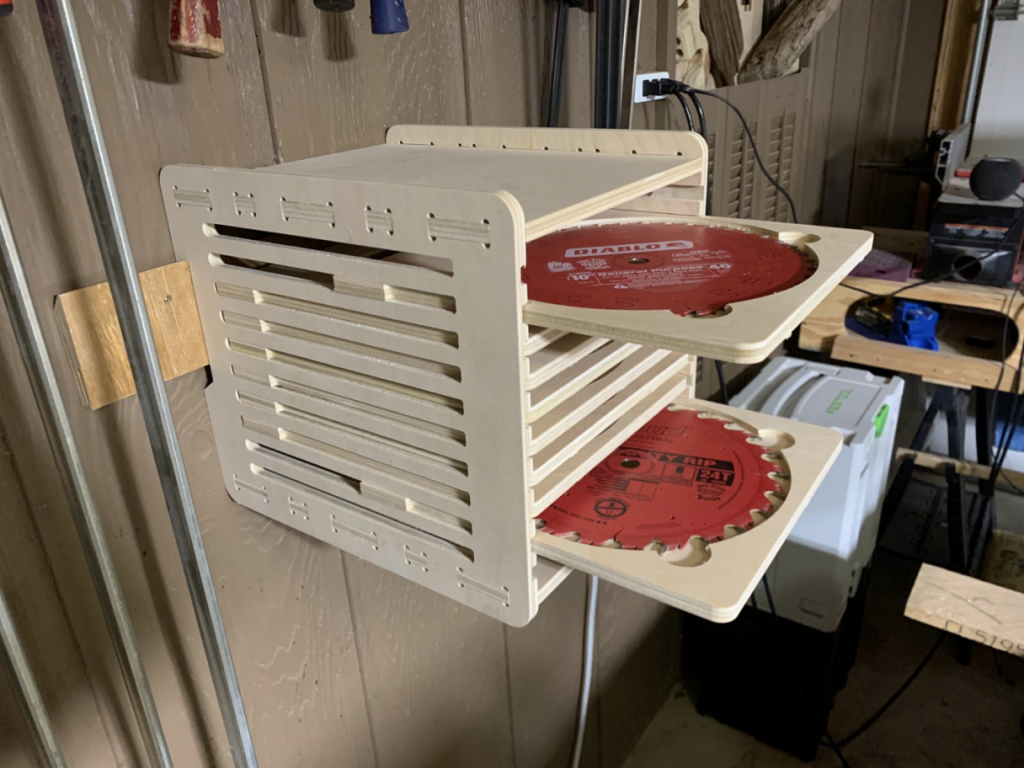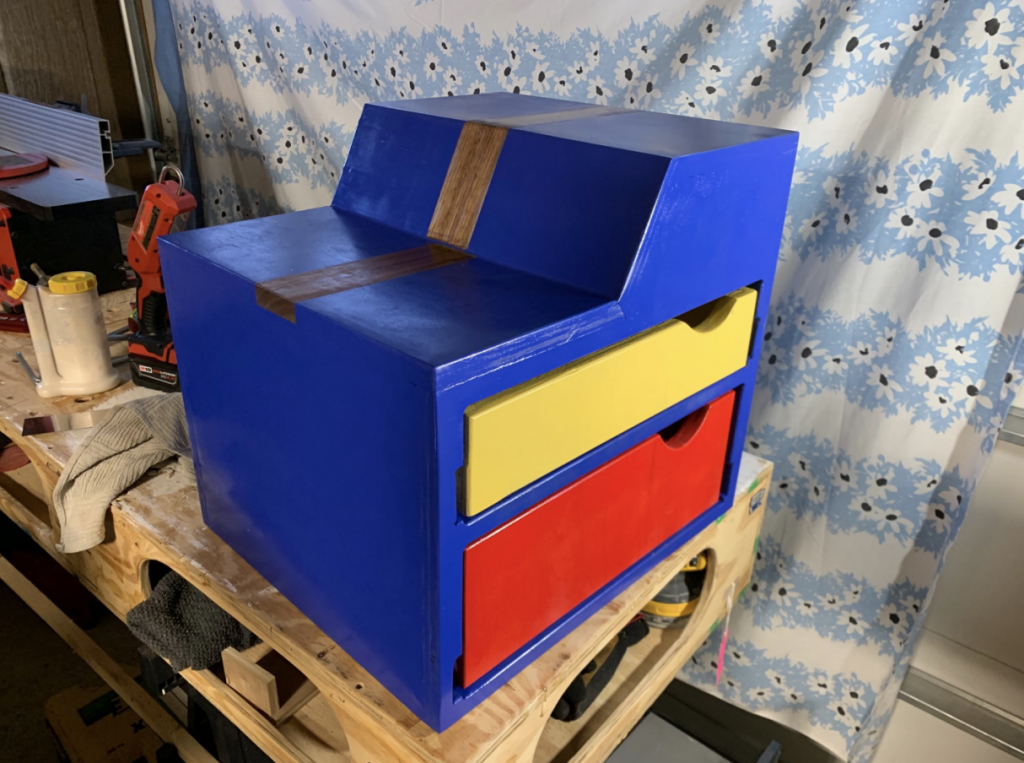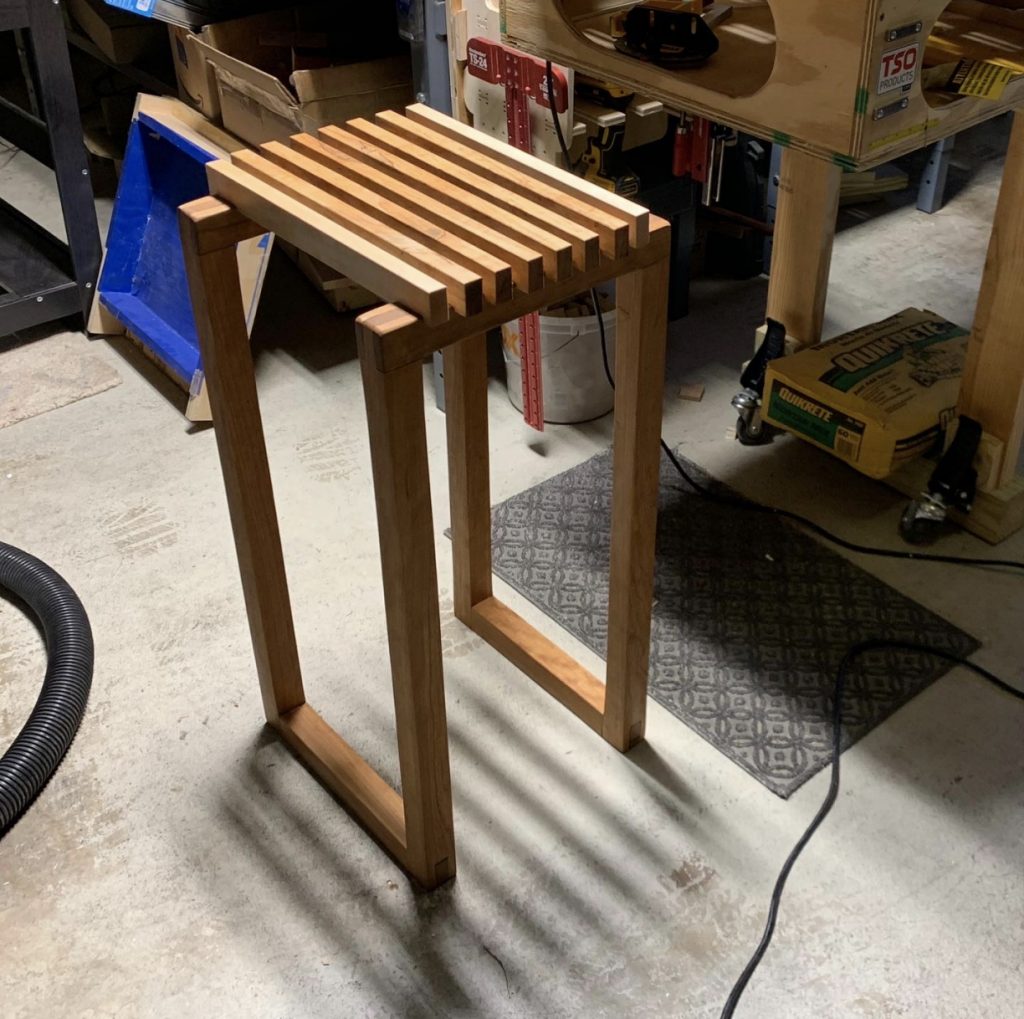Two roads diverged in a wood and I —
Took both; and a third, fourth, fifth, sixth… Briefly, I started woodworking with 3D design, followed by rough carpentry, finish carpentry, 2D design, handheld CNC, gantry CNC, fine woodworking, finishing, hand woodworking, carving, etc… Today I spend hours each night hand cutting pin and tail boards in pursuit of near perfect dovetails.
Along each of these roads, I have learned something that has helped me move further down the other roads. While touching a little bit of everything has been fun and expensive, upon reflection taking so many roads has left me a little bit lost! In an effort to re-focus, I retraced my steps and began segmenting the woodworking I do into three major disciplines; digital, hand and power.

Blade storage – Designed with Illustrator and cut
with CNC from 1⁄2” Plywood
Every woodworking project falls into one of these three disciplines as the predominant ‘tool’ used to accomplish the task. Take building a planter box, if I use a circular saw to cut the parts and an impact driver to join them with screws, its power woodworking. If I instead use a hand saw to cut the parts, and lap joints or tenons to join them, hand woodworking. If I design the parts in Illustrator, use a CNC to cut the parts, then join them with tenons through dogbones, digital woodworking.
These are ‘in a vacuum’ examples. They are focused on exclusively using only tools the discipline would imply and afford me to use. The reality is, most of us will end up doing some form of hybrid woodworking, and that’s how I ended up taking so many different roads. In hindsight, I sometimes wish I could go back to just one road.
So how do I categorize a project I am working on? In my opinion it is the tool I use to make the final components for a project. I stress final because there is a lot of preparation that goes into woodworking, especially if you are using rough sawn or minimally surfaced boards.

Bauhaus Box – 3⁄4 inch Plywood cut with a Track saw. Corners rounded over with a handheld router. Hand pull cut out with a jig saw. Walnut accent strip because I mismeasured.
Let’s say I want to put my hand sawn dovetails to use, what discipline would I use? To start, I will need boards. To prepare them I need to joint and plane them. The hand method will use jointer and planer planes, power the same just attached to an electrical outlet, and digital with a straight and surfacing bit. Boards in hand, time to cut them to the dimensions I need. My options are a hand saw, table saw or a compression bit. I miss using my CNC so I’ll use the compression bit. With my parts in hand, time to break out the dovetail saw! Pins fitting tails and a pint of glue later, I have an unfinished nightstand. I need a workout, so I grab a sanding block and get to work. With every edge and corner nice and smooth it’s time for a sealer. Since my arms are sore from sanding, I opt for a power sprayer. After a few coats, I can finally say ‘work complete’.
Time to share my creation with #woodworking. How do I describe how I built it? If I write about every step and what I used for each step, it would be really boring like the paragraph above. Taking into account each step and the three woodworking disciplines, I would say the nightstand is a product of digital woodworking. Huh?
When looking holistically at this piece of fine art, using CNC to create all of the components defined what the nightstand would fundamentally look like and its overall character. Had I hand cut the boards there would be a dimensional difference, however slight, in each component. A table saw would have been closer, but I find even perfectly set up, there is slight variation with each cut depending on blade height, push speed, weather, etc. Assuming I nailed the dovetails, that would be the part of the project I find to be the highlight, but it’s not enough to say the project is hand woodworking.

Planter Stool – Hand cut through tenons throughout. Cherry supports and Ambrosia Maple runners.
Does it really matter? Yes, no, maybe so. It helps if you are new to woodworking and have limited space to work with. I ended up taking so many different roads because I didn’t see anything that broke down woodworking into logical disciplines which leaves me the mental mess I am today. Most of the examples I followed incorporated a little bit of each. I didn’t know what I didn’t know. While digital, hand and power are still vast categories, they do provide a single road to go down, focus on and more importantly master. In the nightstand example, every step could have been done with only CNC, hand or power tools and I would have ended up with virtually the same nightstand.
Either of the three paths will have its own unique points of frustration and satisfaction, but picking one really helps to cut down on the ‘noise’ and expense when getting started. If I had to start all over again I think I would pick hand woodworking with a focus on boxes. It’s quiet, relatively inexpensive, and will build a knowledgebase that easily carries over to the other two. That being said, I think if all I ever did was hand work, I’d eventually get tired of it and quit woodworking. But I’m an electron addict that needs a regular fix.


Nice post.Hope it will help me to start my woodworking project.